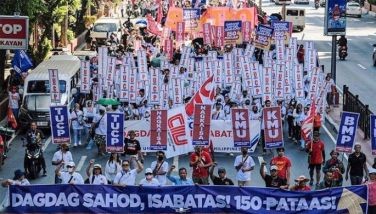QUE UNA ALEGRIA!
Nestled in the southwestern part of Cebu is a humble town blessed with merry people, an abundant marine life and breathtaking landscapes that make it a haven for relaxation and exploration.
With an aggressive campaign to promote countryside tourism in the province, this town has slowly opened its doors to adventure-lovers and to those who long for country life experience.
Alegria is 117 kilometers or a four-hour drive from Cebu City. One can take a bus or V-hire from the Cebu South Bus Terminal at any time of the day.
Alegria has nine big barangays, four along the coast facing Tañon Strait and five in the uplands.
Alegrehanons are mostly engaged in fishing, farming and cottage industries. Some of its leading products are home decors and accessories made from bamboo, which is popularly known as kawayan.
In an effort to further promote the town, Alegria’s local officials led by Mayor Raul Guisadio created the Kawayan Festival, which is celebrated on the first week of December. This highlights the feast in honor of the town’s patron, St. Francis Xavier.
With colorful costumes and a lively drum beat, Algerehanons take pride in showcasing their kawayan products and their rich cultural traditions.
The town got its name after some Spaniards rejoiced, “Que alegre!” when they saw the merrymaking after passing by some natives washing clothes in a spring.
Heritage Sites
Playing a big part in the lives of the town’s people are the things and places that shaped its history.
Displayed in the municipal building are artifacts unearthed in Kambulakan Cave in 1999.
The tourism office also displays photos of the town’s tourist destinations and bamboo products.
Just beside the town hall is the St. Francis Xavier Church built in 1857.
There’s a common belief that gold is buried in the church grounds, as Alegria was the last garrison during the Japanese occupation.
Inside the church, antique statues and images of saints can also be found. This is showcased in every Suroy-Suroy Sugbo Southern Heritage Trail package.
Another historical landmark is the “Bantayan sa Hari” right across the church. It is one of the watchtowers built during the time of a Fr. Bermejo, who ordered their construction along the coast of southern Cebu to alert and protect the towns from invading pirates.
A stroll along the town’s main road gives one the chance to see old houses built during the Spanish and American periods.
Tourist destinations
Caving is one of the activities the town’s tourism officials have been promoting. A few months ago, Salay Cave in Barangay Valencia was featured in a documentary, Planet Philippines, with actor Richard Gutierrez visiting the cave.
The Salay Cave and Kantayong Cave are accredited by the Department of Environment and Natural Resources (DENR), which means these are safe for tourists to enter. A local caving group was also organized to facilitate exploration and spelunking by tourists and other interested parties.
For those who want to experience Salay Cave, Tourism Officer Eric Ybas advises them to secure a permit at the municipal office at P100 per person. A guide costs P100 on the first hour and charges P50 on succeeding hours.
To protect the cave’s unique features, entry is limited to only 10 people at a time. This is an eco-tourism requirement set by DENR.
“Ang atong makita dinhi sa mga formation sa stalagmite ug stalactites sumala sa among mga bisita, taga-Manila, DOST ug Department of Tourism, kay unique gyud ni sa ubang mga nakit-an nga mga caves. Ato ning ikapasigarbo ang Silay Cave tungod sa mga formations niini nga wala sa ubang mga caves,” said Ronnie Basia, a local cave guide.
As a general rule in spelunking, tourists are not allowed to touch anything inside the caves. “Leave nothing but footprints, take nothing but pictures and kill nothing but time,” as the saying goes.
For other side trips, the town also has numerous water systems around its mountains. River-trekking leads one to unspoiled waterfalls, like Cambais Falls and Kawa-kawa Falls, both in Valencia.
For those planning to take their adventure to another level, one can take a motorcycle-ride or “habal-habal” around the paved mountainside roads.
A P100-ride from the town proper takes one to the Libo Hills in Barangay Lepanto. This is called the “little Baguio” of Alegria because of its cold climate, pine trees and vegetable plantations sprawled in the hills. Truly, a breathtaking vista!
Going down from the mountains, another interesting place to visit is Barangay Sta. Filomena, home to a fish sanctuary where tourists can feed marine life.
Sta. Filomena Barangay Captain George Alocillo said the project was expanded to lure tourists to visit and enjoy their barangay.
Entrance fee is pegged at P10 per head.
Alocillo said that most of the visitors spend at least three to four hours in the sanctuary, especially during high tide.
Accommodation
Most of the resorts operating in the town offer diving, snorkeling and dolphin-watching.
In Costa de Letecia, one can enjoy beautiful accommodation as low as P1,000 per night in an air-conditioned room equipped with cable TV and Wi-Fi access. The resort also has an infinity pool and offers different packages.
Another great place to stay is Batong Malunhaw Resort. It is a government-owned resort where one can enjoy an overnight stay in a room for four persons at only P750.
So what are you waiting for? Alegria is just a paradise waiting to be discovered! Dayon na kamo sa Alegria!
- Latest
- Trending























